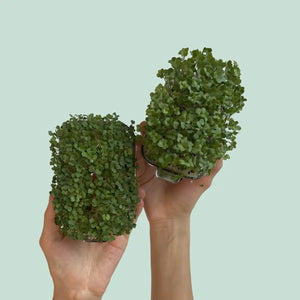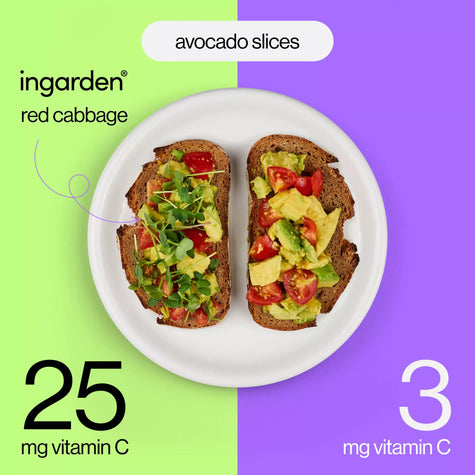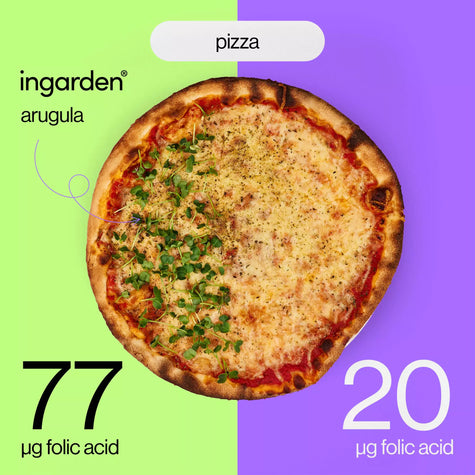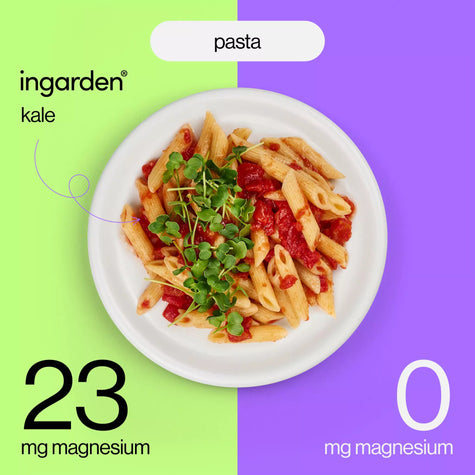Portland – May 23, 2023 - Microgreens, a burgeoning field of interest in the realm of nutrition, have recently captured significant attention for their exceptional nutrient density and potential health benefits. This article aims to provide a detailed nutritional breakdown of microgreens, shedding light on their diverse composition of vitamins, minerals, and antioxidants. We dive into the intricate web of nutritional value embedded within these miniature plants, thereby highlighting their remarkable potential in promoting human health and well-being.
Benefits of Microgreens
Microgreens are a rich source of vitamins, minerals, and other nutrients. They are grown from the seeds of vegetables and herbs and harvested when they are just a few weeks old. Despite their small size, microgreens pack a powerful nutritional punch.
Some of the benefits of microgreens include:
High in Nutrients (Vitamins & Minerals)
Although the specific nutrient content of microgreens can vary depending on the type of microgreen, most microgreens are high in vitamins E,C, and K1. Studies have shown that they can be up to 40 times more nutrient-dense than their mature counterparts. In addition to vitamins, microgreens are also a good source of minerals such as iron, magnesium, and potassium. Iron is essential for the production of red blood cells, which transport oxygen throughout the body. Magnesium is important for maintaining healthy bones, regulating blood pressure, and supporting muscle and nerve function. Potassium is essential for maintaining healthy blood pressure, regulating fluid balance in the body, and supporting proper muscle and nerve function.
Antioxidant-Rich
Microgreens exhibit remarkable antioxidant activity, attributable to their rich assortment of phytochemicals. These bioactive compounds, including carotenoids, flavonoids, and phenolic compounds, play a vital role in neutralizing harmful free radicals, thereby reducing the risk of oxidative damage and inflammation. Consequently, the consumption of microgreens may contribute to the prevention of chronic diseases associated with oxidative stress.
Promote Digestive Health
Finally, microgreens are a good source of dietary fiber, which is important for maintaining healthy digestion and regulating blood sugar levels. Fiber can help promote feelings of fullness, which can help you control your appetite and maintain a healthy weight.
Low in Calories
Microgreens are low in calories and can be added to any dish without adding extra calories to the diet.
Versatile
Microgreens encompass a diverse range of species, each with its distinct nutritional profile and flavor profile. From the zesty tang of radish microgreens to the earthy undertones of bok choy microgreens, the array of taste sensations they offer is as captivating as their nutritional prowess. This diversity encourages individuals to incorporate an assortment of microgreens into their diets, thus reaping the benefits of a wide spectrum of nutrients.
Overall, microgreens are a nutrient-dense food that can provide a wide range of vitamins, minerals, and other nutrients. By incorporating microgreens into the diet, one can benefit from their nutritional content and support overall health and well-being.
Microgreens Nutrition Chart
Microgreens are available in a wide range of flavors and colors, each with their own unique nutritional profile. ingarden collaborated with Eurofins Scientific and BioTeSys, two internationally accredited laboratory testing companies, to conduct a comprehensive nutritional analysis and validate the nutritional integrity of microgreens. We summarized the most important results in the table below. For a full breakdown of each microgreen, scroll down.
mg/100g (% per 100g)
μg/100 g (% per 100g)
| daily recommended dose | arugula | broccoli | kale | mustard | radish | red cabbage | |
|---|---|---|---|---|---|---|---|
|
vitamin B8 (biotin) |
30μg |
5,15μg (17%) |
2,62μg (9%) |
1,89μg (6%) |
7,24μg (24%) |
2,88μg (10%) |
4,79μg (16%) |
| vitamin C | 95mg |
11mg (12%) |
24,1mg (25%) |
15,3mg (16%) |
9,36mg (10%) |
14,6mg (15%) |
21,7mg (23%) |
| vitamin E | 12mg |
0,331mg (3%) |
0,252mg (2%) |
0,08mg (1%) |
0,204mg (2%) |
0,58mg (5%) |
1,32mg (11%) |
| vitamin K1 | 60μg |
17,2μg (29%) |
36,5μg (61%) |
9,11μg (15%) |
11,2μg (19%) |
61,4μg (102%) |
15,9μg (27%) |
| folate | 300μg |
57,4μg (19%) |
33,1μg (11%) |
33,8μg (11%) |
33,1μg (11%) |
39,6μg (13%) |
55,8μg (19%) |
| choline | 400mg |
17,3mg (4%) |
31,3mg (8%) |
18,5mg (5%) |
60,8mg (15%) |
20,9mg (5%) |
53,1mg (13%) |
| calcium | 700mg |
42mg (6%) |
65mg (9%) |
36mg (5%) |
38mg (5%) |
32mg (5%) |
120mg (17%) |
| iron | 10mg |
2,2mg (22%) |
0,73mg (7%) |
0,51mg (5%) |
0,95mg (10%) |
0,48mg (5%) |
0,76mg (8%) |
| magnesium | 300mg |
33mg (11%) |
45mg (15%) |
23mg (8%) |
31mg (10%) |
33mg (11%) |
38mg (13%) |
| manganese | 2mg |
0,74mg (37%) |
0,7mg (35%) |
0,6mg (30%) |
0,44mg (22%) |
0,47mg (24%) |
0,37mg (19%) |
| lutein | 6mg |
4,42mg (74%) |
1,98mg (33%) |
1,94mg (32%) |
0,889mg (15%) |
3mg (50%) |
0,991mg (17%) |
The chart offers a comprehensive overview of the remarkable nutritional content present in various types of microgreens. The data showcases the exceptional density of vitamins, minerals, and antioxidants found within these miniature plants, reinforcing their status as a nutritional powerhouse.
Examining the chart reveals fascinating insights into the vitamin content of microgreens. For instance, broccoli microgreens stand out with their notably high levels of vitamin C, containing up to 24 milligrams per 100g. Vitamin C plays a crucial role in bolstering the immune system and promoting collagen synthesis, contributing to overall health and vitality. Additionally, red cabbage microgreens exhibit great amounts of vitamin E, with levels reaching 1.32 milligrams per 100g. In comparison, an avocado has 2.1mg per 100g, but also a higher caloric intake. Vitamin E, known for its antioxidant properties, aids in protecting cells from oxidative damage and supporting cardiovascular health.
Minerals, equally essential for proper bodily functions, are abundantly present in microgreens. Arugula microgreens boast an impressive concentration of iron, offering 2.2 milligrams per 100g. Iron plays a pivotal role in oxygen transport and energy production, making arugula microgreens a valuable addition to a well-rounded diet.
Furthermore, the microgreens chart highlights the rich antioxidant content in these tiny plants. Arugula and radish microgreens, for instance, exhibit significant levels of lutein, with 4.42mg and 3mg per 100g respectively. Lutein is a carotenoid antioxidant known for its beneficial effects on eye health.
In conclusion, the table provides a compelling snapshot of the vast nutritional benefits microgreens offer. From their robust vitamin content to their mineral richness and antioxidant potency, microgreens stand as a testament to nature's capacity to provide concentrated sources of health-enhancing compounds.
To see a more detailed breakdown for each invidividual ingarden microgreen click on PDF to view and download the results.
ingarden Microgreen Nutrition Data:
ingarden Arugula Microgreens
ingarden Broccoli Microgreens
ingarden Kale Microgreens
ingarden Mustard Microgreens
ingarden Radish Microgreens
ingarden Red Cabbage Microgreens
Furthemore, the analysis compared the microgreen nutrient content with their full-grown vegetable counterparts. The results showed that microgreens have a significantly higher nutrient density compared to their mature counterparts. For example, red cabbage microgreens have 230% more vitamin A per serving than full-grown red cabbage. Arugula microgreens have 600% more copper than full-grown arugula. Broccoli microgreens have 67% more manganese than full-grown broccoli. When compared to mature red cabbage, red cabbage microgreens have 2150% more phosphorus, 2305% more vitamin A, 150% more folate, 88% more manganese, and 15% more biotin, making them a highly nutritious food source.
Microgreens Health Benefits
Arugula microgreens, for example, are high in vitamin A, which is essential for healthy vision and a strong immune system. Broccoli microgreens are rich in vitamin C, which is important for healthy skin and wound healing. Kale microgreens are a good source of calcium, which is essential for maintaining strong bones, and iron, which is important for the production of red blood cells.
Vitamin A is essential for healthy vision, immune function, and cell growth and development. It also helps maintain the health of our skin and mucous membranes. Microgreens such as kale and spinach are excellent sources of vitamin A.
Vitamin C is an antioxidant that plays a crucial role in maintaining the health of our immune system. It helps protect cells from damage caused by free radicals, which can contribute to the development of chronic diseases such as cancer and heart disease. Vitamin C is also essential for the production of collagen, a protein that is essential for the health of our skin, bones, and joints. Microgreens such as broccoli and spinach are rich in vitamin C.
Vitamin K is essential for blood clotting and bone health. It helps our bodies produce proteins that are necessary for these functions. Vitamin K is also important for maintaining healthy blood vessels. Microgreens such as broccoli and red cabbage are excellent sources of vitamin K.
Calcium is a mineral that is essential for maintaining strong bones and teeth. It is also necessary for the proper functioning of our muscles, nerves, and heart. Microgreens such as broccoli and kale are good sources of calcium.
Iron is essential for the production of hemoglobin, a protein that carries oxygen in our blood. It is also necessary for the proper functioning of our immune system. Microgreens such as radish and mustard are rich sources of iron.
Conclusion
Microgreens are a nutrient-dense superfood that offer a wide range of health benefits. By incorporating them into the diet, one can improve overall health and wellness.













